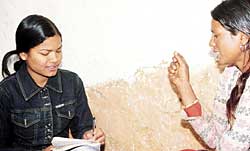 In five years, AIDS will be the biggest killer of Nepalis in the 15-49 age group. One unofficial estimate puts the number of Nepalis with HIV at 80,000. Other estimates are higher.
In five years, AIDS will be the biggest killer of Nepalis in the 15-49 age group. One unofficial estimate puts the number of Nepalis with HIV at 80,000. Other estimates are higher. AIDS is now no longer a risk limited to 'vulnerable groups'. Everyone is at risk because the virus has entered the general population. Communication is the first line of defence against this communicable disease, and since infections are spread by unsafe sex or sharing needles, there has to be awareness at all levels of society.
To start a new approach to communi cating HIV and AIDS awareness, last week Save the Children UK presented 'Our Voice, Our Emotion: a photographic journey' documenting individual voices at the grassroots. The portraits, which capture the voices and emotions of volunteers in Accham and Jhapa who have been mobilising their communities in planning and implementing AIDS awareness activities, will be on display at Standard Chartered Bank branches across Nepal. Called Social Volunteers Against AIDS (SoVAA), these young men and women are involved in awareness campaigns, battling social stigma and discrimination, providing care and support to families with infected members.
People in the remote mid-western district of Achham have traditionally migrated to India. Now, the insurgency has increased the number of people leaving. Neera Khadayat's brother was among those who left. While he was away, she saw villagers ostracise the family of a neighbour who died of AIDS, after coming home from Mumbai with the disease.
 "I realised this could happen to my family too and the fire of pain started to burn," Neera recalls. She learned all she could from newspapers, radio and books and gradually gained her neighbour's trust. The 16-year-old then offered to write letters to family members in Mumbai, informing them about the nature of the disease, what it was doing to their society and how to be safe. Neera wrote to her brother as well. "Lack of knowledge is how it spreads, so that's why we write to our people there."
"I realised this could happen to my family too and the fire of pain started to burn," Neera recalls. She learned all she could from newspapers, radio and books and gradually gained her neighbour's trust. The 16-year-old then offered to write letters to family members in Mumbai, informing them about the nature of the disease, what it was doing to their society and how to be safe. Neera wrote to her brother as well. "Lack of knowledge is how it spreads, so that's why we write to our people there." Kabiram Joshi, 22, witnessed first-hand society's brutality towards an HIV infected neighbour in an Accham village. "After he came back from Mumbai, I saw his neighbours and friends pull him from the car. He was bleeding but they didn't help him-I wondered why. I found out he was HIV positive." The incident motivated Kabiram to become a SoVAA. Kabiram has spent the past two years networking with 60 other volunteers to fight stigma and ostracisation of HIV people. Already, he says he sees less discrimination: children from families with infected members play with others freely and funeral rites are accorded to AIDS victims. The men ask for a fresh blade at the barber's and disposable syringes for their vaccinations.
Ram Bharosha Kunwar watched people in his village dying from AIDS. "Our women became widows, children became orphans. I said this is enough, now I have to fight," says the 58-year-old teacher from Achham. As a volunteer, Ram knows awareness is the only true protection he can give his students. By grade three, he is already talking to students about AIDS.
AIDS is much less of a threat in Jhapa compared to Accham. Jasmine Rajbhandari, head of SC-UK's advocacy unit, says Jhapa is a more urbanised border area where the disease is not so prevalent yet. "But in a few years it could be, in a sense, another type of Accham," she warns.
The social mobilisation initiative targeted high risk youth because they have the motivation and the time to do something to make a difference. Anita Nepali is a dalit, and the 19-year-old has been a volunteer for the past three years dedicating all her free time from school and household chores to work with 12-24 year-old drug users, making them aware of the dangers of sharing needles.


